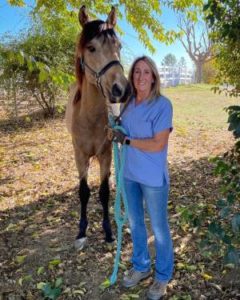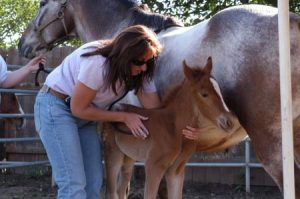Teaching a horse to load into a trailer requires an experienced, patient handler and at least one other experienced person. The method described below is based on reward and some negative stimulation, but no pain. It may take up to 5 sessions to train a horse to load safely. Following are the basic steps involved in one method of teaching a horse to load:
- Park the transport vehicle in a safe place, with minimal distractions for the horse. The footing must be safe. The halter and lead rope must be of sturdy material that will not break. The loading entrance of the transport vehicle must be as open as possible, allowing the person leading the horse a safe way out.
- The person leading the horse into the transport vehicle must always keep the horse’s head pointed toward the loading entrance. This person must not be timid or afraid of the horse. He or she should wear leather gloves to protect the hands.
- Do not use feed to coax the horse into the van. Hay or grain can be placed in the manager as a reward when the horse is loaded.
- The assistant should hold a whip or stiff fishing rod, about 7 feet long, so that he or she can remain some distance from the horse during loading.
- Lead the horse up to the vehicle and use the long whip to tap (not hit) the horse continually from behind to encourage forward progress. As soon as the horse moves forward, stop the tapping. If the horse turns it head away, backs up or halts any forward progress, start tapping again. It’s important to know when to tap and when not to tap the horse. Do not hit the horse with the whip.
- Once the horse is loaded, allow the animal to stand quietly and nibble some hay. Then carefully back the horse down the ramp and repeat the lading process. Repetition is vital when teaching a horse to safely load.
If necessary, tranquilization may be useful in loading some horses, but more often it serves only to quiet an anxious horse during travel.
If the horse is traveling to a competition, you should understand that most shows do not allow these types of medication. The horse may therefore have to be shipped to arrive several days before the competition so as not to violate the medication rules.
If you have any questions or concerns on Loading your Horse for Transport feel free to call us 619-659-1180.

















